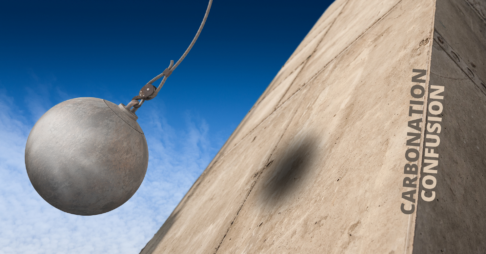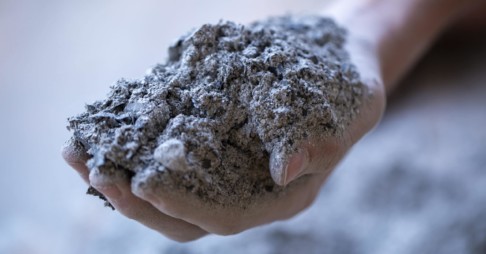With the growing importance of sustainability in the construction industry, more and more concrete producers are recognizing the value of sustainable concrete. But as the hype around sustainable solutions has grown, so have misconceptions about CarbonCure.
In a recent webinar, CarbonCure’s Allison Palmer, Market Development Manager, and Rhett Dunlap, Technical Services Engineer, debunked the common myths they’ve come across about CarbonCure’s concrete technology. They shared the truth about:
- CarbonCure's role with CO₂ capturing
- CarbonCure's impact on concrete
- CarbonCure's affordability and useability
Let’s dive into the 9 facts that debunk those common myths.
Fact #1: CarbonCure is a CO2 mineralization technology
Myth #1: CarbonCure is an aggregate
CarbonCure is not an aggregate, but a technology that injects CO₂ captured from industrial emitters into the concrete during mixing, just like an admixture.
Once introduced into the concrete, a chemical reaction takes place where the CO₂ is mineralized and permanently trapped in the concrete. This process maintains the strength of the concrete while reducing the cement content. Which is good news, because about one ton of CO₂ is emitted for every one ton of cement created.
“It's the same concrete being delivered to your job site, just with a reduced carbon footprint,” said Allison.
Fact #2: CarbonCure does not currently capture, produce, and sell CO₂
Myth #2: CarbonCure captures, produces and sells CO2
CarbonCure doesn’t capture, produce and sell CO₂, but instead takes the CO₂ captured by industrial gas suppliers such as Praxair and Airgas and injects it into the concrete to permanently mineralize it.
Fun fact: The CO₂ used in CarbonCure originates from fertilizer plants, which is also where the CO₂ in our carbonated beverages comes from. But don’t worry — the CO₂ is purified, so your cans of soda and beer are safe for consumption!
Fact #3: CarbonCure has no impact on concrete’s properties
Myth #3: CarbonCure affects the fresh and hardened properties of concrete
The use of CarbonCure’s technology, which adds CO₂ to your concrete mix and reduces cementitious materials by 3-5% on average, doesn’t impact the fresh or hardened properties of your concrete, including finishing, color and durability.
“If we didn't tell you we were using CO₂ mineralization in the mix, you’d probably never know,” said Rhett. The impact of CO₂ on concrete’s durability has been tested extensively. Ongoing durability testing with state regulators, academic studies, CarbonCure’s own intensive lab testing, concrete producer verification, and third party concrete laboratories have shown that CO₂ use in concrete has a neutral to positive effect on all concrete durability attributes studied.
Fact #4: CarbonCure results in the same concrete with less carbon — without compromises
Myth #4: CarbonCure causes corrosion of concrete and rebar
While atmospheric or weathering carbonation can corrode concrete and rebar, the carbonation that comes by using CarbonCure does not.
With atmospheric carbonation, hardened concrete comes into contact with CO₂ in the atmosphere, which changes the concrete’s pH and puts rebar at risk of corrosion. But the early carbonation process with CarbonCure is different. Testing has shown that early carbonation has no impact on the pH of concrete and therefore no impact on corrosion.
Fact #5: CarbonCure improves profitability
Myth #5: CarbonCure adds significant costs to a project
“The majority of our producers are able to provide us to the marketplace at a cost neutral standpoint,” said Allison.
Any costs associated with installing CarbonCure are offset by the savings producers see in reducing the cement content in their mixes. However, at the end of the day pricing is up to the discretion of each producer, so in some cases you may see a 1-2% upcharge for CarbonCure concrete.
With concrete expected to be responsible for half of new construction carbon emissions by 2050, architects, engineers, contractors, owners are all looking for ways to reduce the carbon emissions on their projects. CarbonCure is a great way to do that, and producers who can provide low-carbon concrete will have a competitive edge.
Fact #6: CarbonCure is widely accepted and increasingly specified
Myth #6: CarbonCure is not accepted by existing codes and standards
The American Concrete Institute (ACI) provides requirements for the design and construction of structural concrete in ACI 318 Building Code Requirements for Structural Concrete. ACI 318 states that there is no requirement for minimum cement/cementitious content.
“If you're currently making concrete that meets ACI 318, the use of CarbonCure, which does not negatively impact strength or durability, will continue to allow you to make concrete that meets ACI 318,” said Rhett.
CarbonCure is also compliant with the CSA.
Fact #7: CarbonCure works in all kinds of applications
Myth #7: CarbonCure only works in certain applications
CarbonCure has been used in a wide variety of projects ranging from cold Canadian winters to hot Hawaiian summers. It’s used in many different applications, such as polished concrete floors requiring high flatness levels, in tilt-up wall panels, state departments of transport’s paving applications, in projects with very high exposure classes such as a salt water shark tank, and lots more.
Fact #8: CarbonCure contributes to LEED points
Myth #8: CarbonCure does not support LEED
CarbonCure supports LEED by reducing embodied carbon, which is required under option four of the Building Life-Cycle Impact Reduction credit.
This credit asks project teams to conduct a whole building life cycle assessment and show a 10% impact reduction in embodied CO₂ emissions, plus two other impact categories shown on an Environmental Product Declaration (EPD).
“The exact amount of LEED points can vary even depending upon how much concrete is supplied to the project, but an LCA program like Tally could help quantify these reductions for you, or we could provide you a project carbon savings estimate,” said Allison.
Fact #9: CarbonCure saves 25 lb per cubic yard (15 kg per cubic meter) of CO₂
Myth #9: CarbonCure saves 1 lb per yd3 (0.6 kg per m3) of CO2
On average, CarbonCure for Ready Mix actually reduces CO₂ by about 25 lb per cubic yard (15 kg per cubic meter).
So where does the 1 lb myth come from? “This is a little bit of a trick question,” said Allison. “Our technology injects one pound of CO₂ for every cubic yard, but we reduce about 25 pounds of CO₂ on average per cubic yard.”
That’s because the majority of the carbon savings comes from the 3-6% reduction in cement content you get from using CarbonCure.
Exactly how much CO₂ you will save will vary depending on the mix design, but producers can estimate their carbon savings for projects using the online portal, myCarbonCure.
CarbonCure is on a mission to reduce 500 million metric tons of CO₂ emissions annually — which is equivalent to taking a hundred million cars off the road every single year — but we can’t do it without concrete producers. If you’d like to help reduce concrete's carbon footprint and grow your business at the same time, please contact us to get started.

Razing a Common Misunderstanding: Early-Age Carbonation vs. Atmospheric Carbonation in Concrete

